Books List
Books by Robert D. Turner
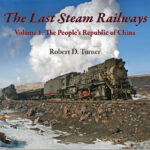
The Last Steam Railways: Volume 1, The Peoples Repubic of China. Harbour Publishing, Madeira Park, B.C., Turner, Robert D. 2022
Featuring over 700 colour photos, a detailed text, maps, references and index.
In the last half of the 20th century, China built over 10,000 coal-burning steam locomotives for its railways. These powerful engines ran in a variety of settings, from an open-cast coal mine near the Siberian border to the remote, semi-tropical hills of Sichuan. They powered passenger trains for nearly 1000 km through the mountains of Inner Mongolia, and pulled local trains on forestry railways in the frozen countryside of northern China.
In 2001, Chinese Railways retired the last of its steam locomotives from its mainline railways. Nonetheless, some regional, local, and industrial operations continued using steam for another decade or more. The photographs and photo essays in this book are a result of many visits to dozens of these diverserailways, where steam was still being used, highlighting the skills of workers as they overhauled and maintained the locomotives and reflecting on the lives of the people who depended upon them in a rapidly changing world.
The Last Steam Railways, Vol.1, The Peoples Republic of China, chronicles the last two decades of China’s fascinating and picturesque steam railways in a visually dramatic and authoritative presentation. It is the first of three volumes that take the story of the last steam railways across Asia, Africa, Europe, and the Americas. With over 700 original colour photographs, graphics, maps, and tables, this is a spectacular addition to any history collection.
Find it on Amazon
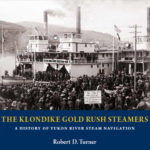
The Klondike Gold Rush Steamers: A History of Yukon River Steam Navigation Harbour Publishing, Madeira Park, B.C., Turner,Robert D, 2019
Featuring over 600 outstanding photos, many in colour, a compelling and detailed text, maps, references and index.
The great Klondike Gold Rush in the Yukon and Alaska started in 1896 and within two years, thousands of prospectors, speculators, business owners and tradesmen came to the Klondike from far and wide, seeking their fortunes.
For the Klondike Gold Rush, sternwheeled steamboats were the essential. Some came by steamer all the way up the Yukon from the Bering Sea at St. Michael while others climbed the famed Chilkoot Pass or White Pass to the headwaters of the Yukon, and took a steamer downstream to the Klondike. From Dawson City and the Klondike, then on to Nome, Fairbanks and other distant places the gold rushes came and faded away.
Skilled officers and crews made these robust frontier boats the lifeblood of the Klondike and Alaskan gold rushes. Over 250 steamboats ran on the Yukon River and its tributaries. After the rushes most were part of the fleets of the White Pass & Yukon Route or the Alaska Railroad. The last ones were retired in the mid-1950s. Many were wrecked, or simply abandoned and left to rot away. Just three, the Klondike, Keno and Nenana, have been preserved as reminders of those exciting and legendary times in the Yukon, northern British Columbia and Alaska.
This book tells the compelling and dramatic story of these amazing steamboats, the people who built and ran them and the services they gave to a vast, lonely, sometimes frenzied and always challenging frontier.
Decades in the making, and based on countless hours of research extending from Five Finger Rapids on the Yukon River to dozens of archival collections, this book presents the fascinating and dramatic history of the Yukon River’s steamers.
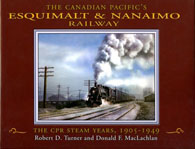 Vancouver Island’s Esquimalt & Nanaimo Railway. The CPR, VIA Rail and Shortline Years, 1949-2013 Sono Nis Press and the British Columbia Railway Historial Association, Winlaw, B.C., Turner, Robert D. and Donald F. MacLachlan. 2013.
Vancouver Island’s Esquimalt & Nanaimo Railway. The CPR, VIA Rail and Shortline Years, 1949-2013 Sono Nis Press and the British Columbia Railway Historial Association, Winlaw, B.C., Turner, Robert D. and Donald F. MacLachlan. 2013.
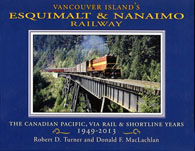 The Canadian Pacific’s & Nanaimio Railway, the CPR Steam Years, 1905-1949 Sono Nis Press and the British Columbia Railway Historial Association, Winlaw, B.C., Turner, Robert D. and Donald F. MacLachlan. 2012.
The Canadian Pacific’s & Nanaimio Railway, the CPR Steam Years, 1905-1949 Sono Nis Press and the British Columbia Railway Historial Association, Winlaw, B.C., Turner, Robert D. and Donald F. MacLachlan. 2012.
 Steam Along the Boundary, Canadian Pacific, Great Northern and the Great Boundary Copper Sono Nis Press, Winlaw, B.C., Turner, Robert D. and J.S. David Wilkie. 2007.
Steam Along the Boundary, Canadian Pacific, Great Northern and the Great Boundary Copper Sono Nis Press, Winlaw, B.C., Turner, Robert D. and J.S. David Wilkie. 2007.
This book was my second collaboration with my good friend Dave Wilkie, who passed away in 1998. Dave and I had previously written The Skyline Limited and this was the next part of documenting the interplay of the Great Northern and Canadian Pacific in southern British Columbia. We had hoped to do a third book about the Crowsnest Pass, but Dave’s health was failing and he died before the second book was done. I haven’t given up on the Crow story, but it is still a few years away.
We had both spent a lot of time in the Boundary District, exploring and hiking the railway routes, photographing railway operations in BC and Washington, examining old mine and smelter sites, and working to grasp and record this complicated history. We both read a lot of old newspapers, Dave visited Great Northern archives in Minnesota and I was able to dig into Canadian Pacific papers as well as having other material copied for us. We had the text well along in 1998, but after Dave’s death it took me sometime to build up steam again and get on with the project, writing, editing, sorting photos, scanning them, ordering others from archives, and then developing a layout and doing the pre-press work for the book. Max Jacquiard did a wonderful painting for the cover. Sono Nis published it in 2007, and it became a BC bestseller and won the Canadian Railroad Historical Association’s book award.
Here is the Sono Nis catalog description:
Steam Along the Boundary, by Robert D. Turner and J.S. David Wilkie
Steam Along the Boundary brings to life one of the most fascinating eras of British Columbia’s railway and mining history: the great copper boom that seized the Boundary District in the late 1890s and early 1900s. The rival Great Northern and Canadian Pacific railways, along with the fledgling Kettle River Valley Railway, were the major players in a fierce competition for the rich ores from the region.
After less than 25 years the boom was over, the mines depleted and the smelters gone, but the railways remained, carrying passengers, lumber, fruit and settlers through the rugged and beautiful mountains.
11×9, 224 pages, 300 plus b/w and 27 colour photos, 3 colour maps. ISBN 13:978-1-55039-158-9. Hardcover, $49.95.
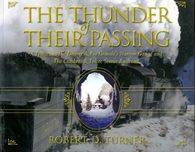 The Thunder of Their Passing, A Tribute to the Rio Grande’s Narrow Gauge and the Cumbres & Toltec Scenic Railroad Sono Nis Press, Winlaw, B.C. 2003
The Thunder of Their Passing, A Tribute to the Rio Grande’s Narrow Gauge and the Cumbres & Toltec Scenic Railroad Sono Nis Press, Winlaw, B.C. 2003
The southwest deserts and high country have captivated me since I was a teenager, and first visited “Narrow Gauge Country” in 1966 when steam was still running over the Rio Grande to Durango and Farmington. Nancy and I spent our honeymoon camping through the southwest and visited Durango, Chama, Alamosa and other key points along the narrow gauge, but just a few months too late. Service had ended the year before, and preservation moves were gathering support, but nothing was running. Later we returned a number of times and in mid-1990s I started on a project to write a book about the railroad that I hoped would contribute to its preservation and appreciation. It took some years, digging into archives in both states, taking several thousand photos and a lot of travel, hiking and driving to complete. During that time I met and got to know many people who worked on the railroad or depended on it, from veteran engineers and firemen to master car builders and ranchers or travellers who remembered the wonderful service on the legendary San Juan Express. Some of these gracious people had worked on the narrow gauge in the early 1900s providing precious recollections of times long past. Over the years I also met many photographers who had worked hard to document the railroad over several generations. I was delighted by the generosity and contributions of such lens masters as Dick Kindig, Jim Shaughnessy, Richard Steinheimer, Ernie Robart, Roger Cook, Dave Wilkie and Steve Patterson, as well as many others.
I traveled on the Cumbres & Toltec many times, followed the rotary snow plow or a flanger train in winter, watched a train climbing to Cumbres Pass in a midnight thunderstorm, sat in the shops as veterans worked on engines that were nearly 100 years old, and got to know train crews, volunteers and friends of the railway who have done so much to keep it alive. Bill Lock, who has been instrumental in the Friends of the Cumbres & Toltec since its founding, wrote the forward to the book. Designing the book was a challenge that I enjoyed, and it was published in 2003.
The Sono Nis catalog provides this outline of the book:
This stunning volume chronicles the story of the most spectacular preserved steam railroad in North America from its origins as the Denver & Rio Grande’s San Juan Extension to its present-day operations as the Cumbres & Toltec Scenic Railroad. The books spans more than 120 years of railroading in the breathtaking high country of Colorado and New Mexico.
288 pages. 11×9 inches. Many colour and b/w photos and maps. Hardcover, $59.95 and softcover, $49.95. ISBN 1-55-39-130-5.
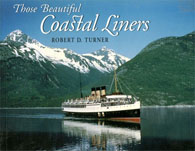 Those Beautiful Coastal Liners, The Canadian Pacific’s Princesses Sono Nis Press, Winlaw, B.C.
Those Beautiful Coastal Liners, The Canadian Pacific’s Princesses Sono Nis Press, Winlaw, B.C.
After Pacific Princesses came out in 1977, I continued to find interesting photos and information about the Canadian Pacific’s steamships that were so important all along the northwest coast of North America from Seattle all the way north through British Columbia to Skagway. I’d long thought I would like to do a companion volume on the Princesses, when Diane Morriss asked me if I had anything ready for publication for 2001. Steam Along the Boundary and other railway projects still needed a lot of work to bring them to publication, but “Princesses II,” as I usually called it, was well in hand. So it was brought to the top of the list. I couldn’t resist the opportunity to write what I hoped would be a beautiful album and expansion of the history of these ships.
For this project I benefitted immensely from the historical papers saved by the late Earl Marsh who worked for the Coast Service beginning in the 1920s and continuing until his retirement in the twilight years of the Princesses. Earl lent me his albums and we had been talking about the Princesses over many visits. Here were correspondence and telegrams from Captain James Troup, manager of the Coast Service, as well as timetables, planning reports and clippings and hundreds of other documents. It was wonderful material to work with. At the same time Maurice Chandler, who had been photographing ships around Victoria and Vancouver for decades, lent me his precious colour slides and negatives of the Princesses from their pre-war years (in black & white) to the retirement of many of the ships in the early 1950s (in colour and black & white). Of course there were other photo sources including the Dedman studio in Skagway, which helped with the beautiful cover photo of the Princess Kathleen nearing Skagway. Clinton Betz in Seattle also came to my rescue with his fine photos that reflected his careful camera and darkroom work. The result was Those Beautiful Coastal Liners, The Canadian Pacific’s Princesses, published in 2001. The book provided a 160-page treatment of the coastal liners with nearly 250 new photos (that were not used in Pacific Princesses) including colour from as far back as the late 1940s, and lots of new historical material and personal recollections. Maybe one day there will be a third volume that will focus on the north coastal steamship services. Coastal Liners was the first of my books in the 11 x 9 album format. Coastal Liners remains one of my favourites of the maritime history books I’ve worked on with Sono Nis.
The Sono Nis Catalog had this to say:
Those Beautiful Coastal Liners, The Canadian Pacific’s Princesses.
A companion volume to Robert Turner’s earlier book, The Pacific Princesses. Remembered for their elegance, luxury and reliability, the Princesses were the finest coastal liners on the Pacific coast. They established an enduring reputation for elegance and beauty that remained unmatched for over 60 years. Their name became legends along the coast: The Princess Victoria, Princess Kathleen, the lovely Princess Marguerite and others.
160 pages, 11 x 9, 240 plus b/w and colour photos, illustrations and maps. ISBN 1-55039-109-7. Softcover, $39.95.
Steam on the Kettle Valley. A Railway Heritage Remembered Sono Nis Press Victoria, B.C. (A project of the Kettle Valley Railway Heritage Society and the Royal B.C. Museum) 1995
In 1995 work was progressing on developing a steam railway on part of the abandoned Kettle Valley Railway near Summerland in the Okanagan Valley. Jim Wardrop of the Royal BC Museum, who was working on the project, asked me about doing a book to support and help promote the new railway. My thought was that the history of the railway was very well recorded by Barrie Sanford in his fine books, but there was an opportunity to present recollections of people who had worked on the railway, travelled on it or depended upon the KVR. I’d met and interviewed a number of KVR people over the years, including Perley McPherson and Gordon Fulkerson, and was anxious to follow up on this work. It proved to be a rare and rewarding opportunity, as well as a privilege to meet more wonderful veterans of the railway and share their stories. With the earlier interviews I had done, I was able to include material from people who had worked on the KVR since its beginnings before World War I through to the abandonment of the railway. Within a very short time, most of these veterans had passed on. Photographic contributions came from many friends including Gib Kennedy, L.S. “MO” Morrison, Ray Matthews, Bob Loat and Lance Camp, to name just a few. The book was published by Sono Nis and was a project of the Kettle Valley Steam Railway Society in cooperation with the Royal BC Museum.
I couldn’t finish off the first edition until the Kettle Valley Steam Railway was operating, and it was a delight to be there when the first trains ran between West Summerland and Trout Creek over Kettle Valley track. With photos in hand we hurried to get the book out as fast as possible to help support the railway. That was in 1995.
Things change, even on an abandoned railway with sections that had become important heritage sites. On the Kettle Valley, the steam railway received and started using former CPR steam engine 3716, a 2-8-0 ideally suited to the operation and of the class used extensively on the KVR. The 3716 ran there and elsewhere in southern BC. Then in the hot dry summer of 2003 horrible fires swept through the southern Okanagan, destroying many home and most of the trestles on the Kettle Valley in Myra Canyon. The bridges had become a major heritage attraction on a wonderful hiking and cycling trail. The rebuilding effort was massive and exceptional, and that story had to be added to the book, leading to an expanded second edition published in 2009. I was also able to include additional photos and recollections of Joe Smuin, KVR historian, about his family’s long association with the railway. I highly recommend Joe’s detailed book Kettle Valley Railway Mileboards.
The Sono Nis catalog described the book this way:
Steam on the Kettle Valley, A Railway Heritage Remembered, Robert D. Turner
Second Edition
From the earliest days of surveying and railway construction, to battling snows in the mountains, to shipping the Okanagan’s prized fruit, here are the stories of Kettle Valley railwaymen recalling the railway as it was. Interwoven with outstanding photographs and carefully researched historical text, this beautiful book celebrates the famed Kettle Valley Railway of southern British Columbia. The legacy of the Kettle Valley lives on in outstanding heritage sites and attractions such as the Kettle Valley Steam Railway.
This new expanded and enhanced edition presents the return of locomotive 3716 to the KVR and the story of the Myra Canyon fire, as well as the rebuilding of its magnificent trestles. The book now features four beautiful paintings by renowned railway artist Max Jacquiard.
144 pages. 9×8 inches. Many colour and b/w photos and maps. ISBN 13:978-155039-170-1 and 10:155039-170-4. Softcover, $24.95
_____________. 2009 (expanded second edition) Sono Nis Press, Winlaw, B.C.
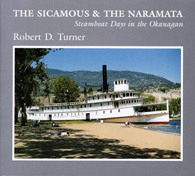
The Sicamous and the Naramata. Steamboat Days in the Okanagan Sono Nis Press, Victoria, B.C. (A project of the SS Sicamous Society and the Royal B.C. Museum)
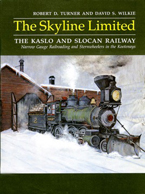
Turner, Robert D. and David S. Wilkie. 1994. The Skyline Limited. The Narrow Gauge Kaslo & Slocan Railway and the Sternwheelers of Kootenay Lake Sono Nis Press, Victoria, B.C.
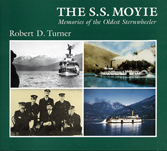
S.S. Moyie. Memories of the Oldest Sternwheeler. Sono Nis Press and the Kootenay Lake Historical Society, Victoria, B.C.
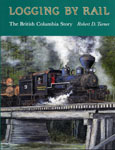
Logging by Rail. The British Columbia Story. Sono Nis Press, Victoria, B.C.
I’ve been fascinated by the logging railways in British Columbia, in the western states and in places as distant as northern China and Indonesia for many years. In BC, the forest industry was the last place were steam was used, except for Bob Swanson’s two Pacific Coast Shays in North Vancouver and on heritage operations including the BC Forest Museum at Duncan, founded by Gerry Wellburn (to whom the book was dedicated). For me, my first encounter with these often-unique engines, was at Ladysmith, when in the early 1950s, I saw Comox Logging’s collection of engines outside their shops. These engines with their large spark arrestors and weathered appearance, and the first closeup look I’d had of a Shay, left a lasting impression. My curiosity about these engines led to writing Vancouver Island Railroads some years later and then in 1990 completing Logging by Rail
Living in Victoria made it possible to visit Hillcrest, MacMillan Bloedel and Comox Logging regularly and I was also able to see Canfor on northern Vancouver Island, and the Elk Falls mill north of Campbell River on several trips. Always I had a camera or two along, and these visits added photographs that would eventually be used in these books.
The background story that eventually became the text came from archival sources, government records, interviews with veterans, walking old abandoned rights of way, locomotive builder’s records, studying air photos and maps, and published sources and journals. Intertwined too was the story of the forest industry in British Columbia and the complex ecology of the temperate rainforests that were the basis of this industry and consumed by it. This project was ongoing for about 25 years.
Logging by Rail was published in 1990, and it was most recently reprinted in 2010 after all the original material was scanned and reprocessed. I also added an update and addenda to the book. It won the Canadian Railroad Historical Association’s Book Award when first published.
Here is the Sono Nis catalog information:
Logging by Rail, the British Columbia Story
An insightful history and a sweeping portrait of railroad logging in British Columbia. The book begins with the small rail logging operations of the 1880s and continues through the height of the steam era, two world wars, the Depression, the change to truck logging and the last steam and dieselized logging lines. Stunning photos, specialized steam equipment, maps, plans, interviews and a carefully researched text highlight this favourite.
326 pages, 8.5 x 11, 500 plus b/w and colour photos, ISBN 1-55039-065-1. Softcover, $39.95.
_____________. 2011 (expanded second edition) Sono Nis Press, Winlaw, B.C.
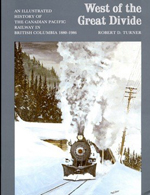 West of the Great Divide. An Illustrated History of the Canadian Pacific Railway in British Columbia, 1880-1986 Sono Nis Press, Victoria, B.C.
West of the Great Divide. An Illustrated History of the Canadian Pacific Railway in British Columbia, 1880-1986 Sono Nis Press, Victoria, B.C.
Sternwheelers & Steam Tugs. An Illustrated History of the CPR’s British Columbia Lake & River Service Sono Nis Press, Victoria, B.C.
_____________. 1998 (expanded second edition Sono Nis Press, Winlaw, B.C.
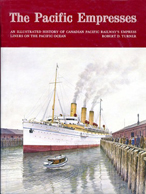
The Pacific Empresses. An Illustrated History of the CPR’s Trans-Pacific Ocean Liners Sono Nis Press, Winlaw, B.C.
Following the publication of Pacific Princesses in 1977, I couldn’t resist moving on to the story of the CPR’s record-breaking Empress liners on the company’s trans-Pacific service. During the course of my work on the history of these liners, I met many veterans of the service, and they helped to expand personal insights into the history of the steamship line back into the early 1900s, including particularly their services during World War II. They lent me photos and documents and told me of the long years away from home during the war and the happier times on the trans-Pacific route. Shipping records and Canadian Pacific archival material, as well as engineering records and reports, all contributed to the story, as did a lot of time spent reading newspapers. The arrivals and departures of the ships were often reported in the papers along with news of their cargos, including silk and spices. The papers also recorded record-breaking runs and the important people who were travelling on the White Empresses, as they were often called. Understanding the role of the liners also meant a lot of reading into broader maritime, naval and the general history for the period between the late 1800s and the end of World War II. I also had the privilege of being given access to the wonderful collection of Dr. Wally Chung and spending many hours in his home talking about the Empresses and looking at his material. The Chung collection is now at the University of British Columbia library, and much of Wally’s extensive library is housed at the Vancouver Maritime Museum. My long time friend Leonard McCann, curator at the Vancouver Maritime Museum, was ever helpful as he was for so other many authors and historians.
Once again Harlan Hiney, this time working from archival images and photos I took of the builder’s model of the Empress of Russia, painted the dramatic cover image for the book. This one featured the majestic Russia, new and at the Victoria docks, with a large crowd of people on hand to see the beautiful liner. Empresses was published in 1981, four years after Princesses, and that seemed to set the pace for the spacing of most of my future books. There were only so many evenings, lunch hours and weekends when I could work on these projects, and the books always took longer than I would have liked. That year I also finished a small book on the Princess Marguerite and an issue of Sound Heritage called Railroaders, Recollections from the Steam Era. Both of these are now out of print. Empresses, like Princesses, was reprinted in 2004 in an updated edition (hardcover and softcover) with additional new material and photos.
Here is the Sono Nis catalog information:
The Pacific Empresses. The illustrated history of the CPR’s trans-Pacific liners. For over 50 years these beautiful ships provided a fast lnk with the Orient. With its companion, The Pacific Princesses, this volume is essential addition to any history- or ship-lover’s library.
304 8.5 x 11 in pages. 375 plus b/w and colour photos, illustrations, maps & timetables. ISBN 1-55039-149-6 softcover, $39.95; ISBN 0-919462-61-8, hardcover, $49.95.
___________. 2004 (expanded second edition), Sono Nis Press, Winlaw, B.C.
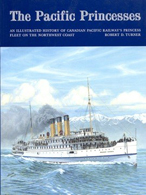 The Pacific Princesses, An Illustrated History of the Canadian Pacific’s Princess Fleet on the Northwest Coast
The Pacific Princesses, An Illustrated History of the Canadian Pacific’s Princess Fleet on the Northwest Coast
My second book, and the first of the maritime history titles, The Pacific Princesses, was published in 1977. It was also the start of many projects I have done with Sono Nis Press. This was also one of the first regional history books that Dick Morriss published after he took over Sono Nis. This was the beginning of a delightful author-publisher relationship that is approaching its 40th anniversary, first working with Dick, and then after he passed away, with his daughter Diane who has owned the publishing company since that time.
Some of my earliest travel recollections were of the Canadian Pacific’s beautiful steamships, nearly all named after Princesses, that operated all along the British Columbia coast and to Washington and Alaska. As a boy I travelled with my family on such ships as the Princess Joan and Princess Elizabeth, often on the night boat runs between Victoria and Vancouver, or on the Princess Louise on the daytime service in the winter when she was not running to Alaska. The newer Princess Patricia and Princess Marguerite also were favourites. Those were the years before the start of the modern BC Ferries services and times were a little more leisurely. For overnight trips, the steamers had comfortable staterooms, although I also remember sitting up in the passenger lounge, with suitcases for seats, on holiday trips when there were no staterooms available. A meal in the dining room was a special treat in an era when the CPR prided itself on its passenger services and cuisine.
As Vancouver Island Railroads was nearing completion in the early 1970s, I dug deeper into the story of the coastal boats I remembered so well, and followed the declining fortunes of the Princesses in the 1970s. Ultimately, the archival work and photography led to the publication of The Pacific Princesses. This book was printed at Morriss Printing in Victoria, the well-respected company owned by Dick Morriss and his father Richard and Dick was also the owner of Sono Nis Press. For me it was a wonderful education to see the book take shape. The type was set in hot type metal, the photos were transformed into halftones in the lab and the design was developed by Bev Leech and then turned into printing flats and ultimately printing plates. The bindery took the printed sheets, with four book pages to each side, and turned them into sewn hardcover books. At the same time I’d asked Harlan Hiney, who had painted the cover for Vancouver Island Railroads, to paint the beautiful cover scene of the elegant Princess Victoria crossing Juan de Fuca Strait at full speed, with the Olympic Mountains in the background. I also spent a lot of time working on drawings of the Princesses, etching into my mind the distinguishing features of the ships.
Princesses was reprinted a number of times and in 2004 we prepared an updated edition with additional photos and illustrations, including a colour section, and it was released (in hardcover and softcover) along with an updated edition of its companion book, The Pacific Empresses.
Here is a Sono Nis catalog description:
The Pacific Princesses. This beautiful, carefully researched and lavishly illustrated book presents the fascinating history of the Canadian Pacific’s famed Princess steamships on the British Columbia, Washington and Alaska coasts. For over 100 years, the Princesses were often the only means of travel along the rugged Pacific coast.
252 8.5 x 11 in pages. 300 plus b/w & colour photos, illustrations, maps and timetables. ISBN 1-55039-150X, softcover, $39.95; ISBN 0-919462-04-9, hardcover, $49.95.
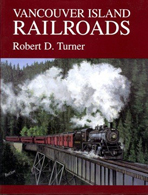
Vancouver Island Railroads Turner, Robert D. 1973. Golden West Books, San Marino, CA
___________. 1997 (expanded second edition), Sono Nis Press, Victoria, B.C.
Sono Nis, Winlaw BC
